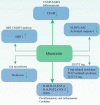Protective role of flavonoids quercetin and silymarin in the viral-associated inflammatory bowel disease: an updated review
- PMID: 37249707
- PMCID: PMC10228462
- DOI: 10.1007/s00203-023-03590-0
Protective role of flavonoids quercetin and silymarin in the viral-associated inflammatory bowel disease: an updated review
Abstract
Inflammatory bowel disease (IBD) is a chronic recurrent inflammation of the gastrointestinal tract (GIT). IBD patients are susceptible to various infections such as viral infections due to the long-term consumption of immunosuppressive drugs and biologics. The antiviral and IBD protective traits of flavonoids have not been entirely investigated. This study objective included an overview of the protective role of flavonoids quercetin and silymarin in viral-associated IBD. Several viral agents such as cytomegalovirus (CMV), Epstein-Barr virus (EBV), varicella zoster virus (VZV) and enteric viruses can be reactivated and thus develop or exacerbate the IBD conditions or eventually facilitate the disease remission. Flavonoids such as quercetin and silymarin are non-toxic and safe bioactive compounds with remarkable anti-oxidant, anti-inflammatory and anti-viral effects. Mechanisms of anti-inflammatory and antiviral effects of silymarin and quercetin mainly include immune modulation and inhibition of caspase enzymes, viral binding and replication, RNA synthesis, viral proteases and viral assembly. In the nutraceutical sector, natural flavonoids low bioavailability and solubility necessitate the application of delivery systems to enhance their efficacy. This review study provided an updated understanding of the protective role of quercetin and silymarin against viral-associated IBD.
Keywords: Antiviral traits; Inflammatory bowel diseases; Quercetin; Silymarin; Viral infections.
© 2023. The Author(s), under exclusive licence to Springer-Verlag GmbH Germany, part of Springer Nature.
Conflict of interest statement
The authors confirm that this article content has no conflict of interest.
Figures






References
Publication types
MeSH terms
Substances
LinkOut - more resources
Full Text Sources

